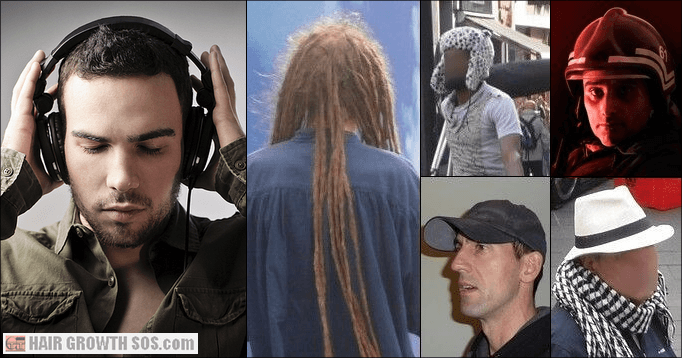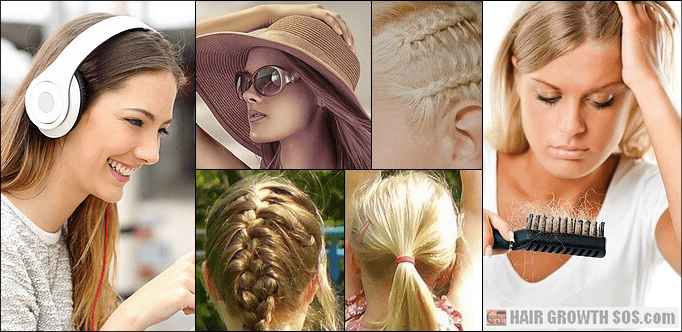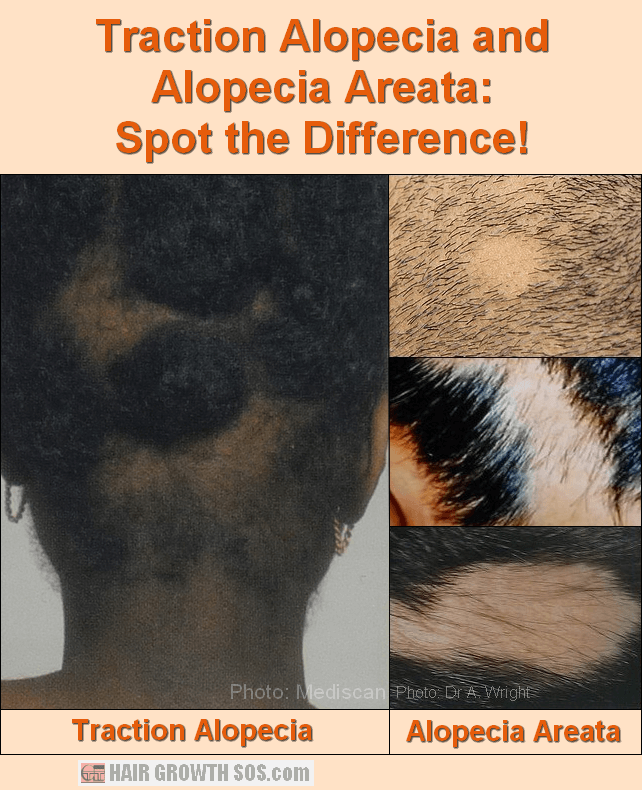- Home
- Causes of Hair Loss
- Friction Alopecia
Friction Alopecia (Traction Alopecia) In Men And Women
By Paul Taylor
Friction alopecia (traction alopecia) can develop if you regularly wear braids, bands, clips, caps, hats, helmets, etc.
All these things can their toll on a healthy head of hair by constantly rubbing and tugging at your scalp.
And whilst all these head-wear items should only cause temporary hair loss, if you don’t get to grips with it quickly, it could eventually become permanent if it develops into a scarring form of alopecia (1).
Even innocuous items like wearing headphones might cause hair loss if you leave them on for hours every day of your life, use them during rigorous exercise and they're not good quality (i.e., they don't fit well or have good padding).
This article explains how friction alopecia can develop in men and women,
and suggests five action steps you can take which might help your hair recover.
Friction Alopecia in Men: Does Wearing A Hard Hat Cause Baldness?

For most men, the term "baldness" means full male pattern baldness. In which case, "no" is the simple answer to that question.
However, certain types of head-wear can cause localized bald spots, or make any existing hair loss problem you have, worse.
Men can develop small areas of friction or traction alopecia if a hard hat, helmet, baseball cap, etc. is worn regularly and/or for a prolonged period of time (e.g., every day at work, or playing hours of sport at the weekend).
It might just be the back of the scalp that gets affected because that's likely to be where most abrasion occurs.
If so, the hair loss it causes could be quite localized (perhaps just a small amount of shedding due to a cap that's too close fitting). And that’s something that can easily go unnoticed.
But, over time, it's possible that more severe hair loss can develop, and a small bald spot starts to form. And that’s something you, and other people, will notice.
Professions that wear hard hats and helmets
First of all, the idea that professions like firefighter or construction worker can actually cause male pattern baldness simply because they regularly wear a hard hat or helmet, is just a popular hair loss myth.
I believe male pattern baldness is driven by skull expansion (a mechanism influenced by certain genes and hormones).
But, clearly, if you start developing traction alopecia in addition to any male pattern baldness you might already have, this is only going to make matters worse.
You might want to hide your hair loss from the world, but constant abrasion from your head-wear might dislodge a noticeable amount of hair from the male pattern baldness region of the scalp over time.
Another concern is how hot and sweaty it can get underneath, say, a baseball cap. If worn whilst playing an active sport for hours on end, such a hot, sweaty environment is not exactly healthy or hygienic for the scalp.
Permanent hairstyles
Excess combing might just cause friction alopecia too. And this is especially true in men more so than women.
Men
usually keep the same parting year after year, whereas women tend to
change their hairstyle more frequently. And a link to traction alopecia
certainly has been reported in some people with permanent hairstyles (2).
Also, men suffer severe hair loss (from androgenetic alopecia) far more than do most women. And since a parting is likely to be within the male pattern baldness region, this hair is already weaker and so, more likely to fall out.
Friction Alopecia in Women

In today's world, hair is very much seen as a fashion item, as well as a sign of health and beauty.
Hair is, therefore, often brutalized by chemicals and accessories in order to serve this cosmetic purpose. And, of course, this mostly applies to women.
Women tend to change their hairstyle much more often than men, and I think this could actually be a good thing because it might reduce the risk of localized hair loss (e.g., by changing the position of your parting).
But women are also more likely to make regular use of braids, bands, clips, cornrows, ponytails, etc. Any of which could eventually cause noticeable hair loss to develop, forming small areas of baldness.
The highest risk hairstyles
Unsurprisingly, the key risk factor appears to be how tight the hairstyle or hair accessory is. Obviously, the tighter they are, the higher the risk. The following are considered to be the highest risk styles (2):
- Braids (cornrows and dreadlocks).
- Buns.
- Ponytails.
- Attaching hair weaves and hair extensions.
And, remember, in addition to all these things possibly raising the risk of permanent baldness, friction alopecia might also contribute to any other type of hair loss you already have.
Basically, strangling hair that is already weak by tying it up in knots could easily cause more hair to fall. Even excess brushing or combing might eventually take its toll if your hair is already thin, fragile and ready to fall from an unrelated disorder.
Traction Alopecia Treatment: 5 Things You Can Do
First, it's important to remember that traction or friction alopecia is caused by a repetitive, physical pulling of the hair. It has nothing to do with genetics, hormones or a medical condition.
And it can't develop into male pattern baldness or any other type of hair loss either.
Traction alopecia does not have to be a long-term or permanent problem as long as you take the right action. So here are five treatment ideas you can try:
1. Identify the cause: Hopefully you've already done that by reading this page. But you probably already suspected traction alopecia if you regularly wear hats, helmets or hair accessories.
However, since traction alopecia often develops into
small bald patches, it can resemble and easily be confused with alopecia
areata (see photos below).
In which case, it would be sensible to learn about alopecia areata in order to (hopefully) eliminate it. And, clearly, going to see a doctor is the recommended way to confirm exactly which condition you have.
2. Review your hairstyle: Stop using all those hair accessories! Ideally, you should avoid them altogether, at least until your hair has started growing back.
At the very least, you should reduce wearing them as much as you can. And if you do need to wear a hat, try to make sure it's a loose fitting one.
3. Keep your hair clean: The subject of hygiene does have a part to play in the hair loss process. So, remove all the braids, etc. and wash your hair every one or two days.
Learn how hair hygiene might contribute to hair loss.
4. Keep calm: Any type of hair loss can cause stress. And stress is only going to makes things worse. So, simply realizing what's causing your hair loss, and knowing that your hair will grow back (given the chance) this should help prevent you from panicking.
5. Diet: Take a good look at what you eat. Avoid junk food and be aware of comfort food or binge eating too (e.g., eating excessively simply to relieve the stress your hair loss might be causing).
Taking in too many calories from the wrong types of food is not
going to help you get your hair back in the area of loss, and could
even make it worse. To learn more, read this article.
Doing all these simple things should gradually improve the health of your hair and give it a chance to grow back.
Conventional Treatment
Obviously it makes sense to consult with a doctor.
The primary approach that a doctor will suggest is probably to simply change the hairstyle or hair accessories causing the problem (point 2 above). And a secondary approach is likely to be one or more of the following (1):
- Anti-inflammatories.
- Hair loss concealer products.
- Hair growth topical treatments.
An Alternative Approach
If you want to do more than just sit, wait and hope that your hair will regrow back to normal, or prefer the of an alternative approach (i.e., rather than the conventional ideas above, then you might consider my techniques.
These are designed to quickly restore healthy hair regrowth for men and women who suffer various types of hair loss.
To learn about my approach, read this FAQ page.
|
Like this page? |
|



Comments and Questions?
Comments and questions about the page you just read are welcome. Just post in the box below. Please also observe the Commenting Rules (opens in a new window).